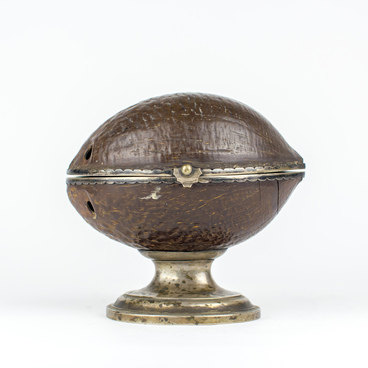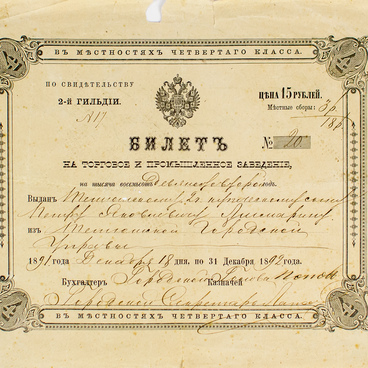The decorative plate presented at the exhibition was made during the reign of Tsar Alexei Mikhailovich and decorated the walls of a merchant’s house in the city of Tetyushi. It has the inscription “By the grace of God the Great Sovereign and the Grand Duke Alexei Mikhailovich of All the Great and Small” and a double-headed eagle.
The double-headed eagle appeared on the Russian coat of arms in the 15th century during the rule of Ivan III. Russia inherited this symbol from Byzantium. In the 4th century, the eagle with two heads was a personal totem of the Roman Emperor Constantine the Great. After he moved the capital to Constantinople the image became the official emblem.
After the collapse of the Roman Empire, Byzantium retained the Roman coat of arms for about a thousand years. The image of a black two-headed bird on a golden banner was brought to Russia by Byzantine princess Sophia Palaeologus, wife of Tsar Ivan III. The Byzantine eagle did not hold any attributes of power in its paws but the royal crowns were depicted above its head.
At that time, the two-headed eagle began to be depicted on a variety of objects: weapons, furniture, ceremonial items, engravings, banners, seals and coins.
Soon the coat of arms changed — in the paws of the eagle appeared a cross and a sword. The cross symbolized Orthodoxy and the sword symbolized the protection of the independence of the new state, which had just got rid of the Tatar-Mongol yoke. The two heads of the eagle were crowned with Monomakh’s cap, an attribute of autocracy. A little later, an icon of St. George, the patron saint of warriors and tillers, began to be depicted on the bird’s chest.
During the Time of Troubles, the symbol of Russia changed a few times. For a while, the eagle was depicted with one head, in the Western manner, as well as in black, not gold in the Byzantine manner. When foreign invaders were expelled from the country, the coat of arms was restored to its original appearance.
With the ascension to the throne of the Romanov dynasty, the coat of arms changed again. It depicted a double-headed eagle with three crowns: two were above the bird’s heads and one above, in the center. Instead of the icon on the chest of the eagle appeared a shield with St. George. While during the confrontation with the Tatar-Mongols, the heavenly protector looked to the east, in the updated version he turned to the west. In his paws, the eagle held a scepter and an orb, symbols of autocratic power.
In the 17th century, when Peter I came to power, the Andrew’s Cross was added to the shield on the eagle’s chest. It was the highest award and the first official order of Russia, approved by the emperor. Above the bird’s head, there was only one crown left, and the eagle itself acquired black feathers again.
The double-headed eagle appeared on the Russian coat of arms in the 15th century during the rule of Ivan III. Russia inherited this symbol from Byzantium. In the 4th century, the eagle with two heads was a personal totem of the Roman Emperor Constantine the Great. After he moved the capital to Constantinople the image became the official emblem.
After the collapse of the Roman Empire, Byzantium retained the Roman coat of arms for about a thousand years. The image of a black two-headed bird on a golden banner was brought to Russia by Byzantine princess Sophia Palaeologus, wife of Tsar Ivan III. The Byzantine eagle did not hold any attributes of power in its paws but the royal crowns were depicted above its head.
At that time, the two-headed eagle began to be depicted on a variety of objects: weapons, furniture, ceremonial items, engravings, banners, seals and coins.
Soon the coat of arms changed — in the paws of the eagle appeared a cross and a sword. The cross symbolized Orthodoxy and the sword symbolized the protection of the independence of the new state, which had just got rid of the Tatar-Mongol yoke. The two heads of the eagle were crowned with Monomakh’s cap, an attribute of autocracy. A little later, an icon of St. George, the patron saint of warriors and tillers, began to be depicted on the bird’s chest.
During the Time of Troubles, the symbol of Russia changed a few times. For a while, the eagle was depicted with one head, in the Western manner, as well as in black, not gold in the Byzantine manner. When foreign invaders were expelled from the country, the coat of arms was restored to its original appearance.
With the ascension to the throne of the Romanov dynasty, the coat of arms changed again. It depicted a double-headed eagle with three crowns: two were above the bird’s heads and one above, in the center. Instead of the icon on the chest of the eagle appeared a shield with St. George. While during the confrontation with the Tatar-Mongols, the heavenly protector looked to the east, in the updated version he turned to the west. In his paws, the eagle held a scepter and an orb, symbols of autocratic power.
In the 17th century, when Peter I came to power, the Andrew’s Cross was added to the shield on the eagle’s chest. It was the highest award and the first official order of Russia, approved by the emperor. Above the bird’s head, there was only one crown left, and the eagle itself acquired black feathers again.



